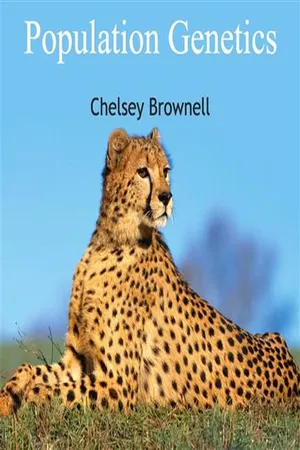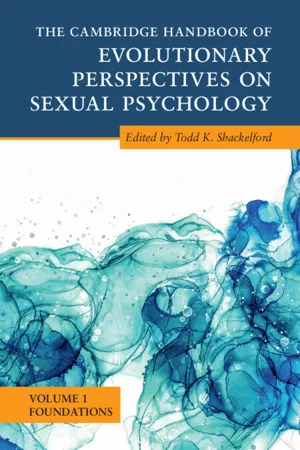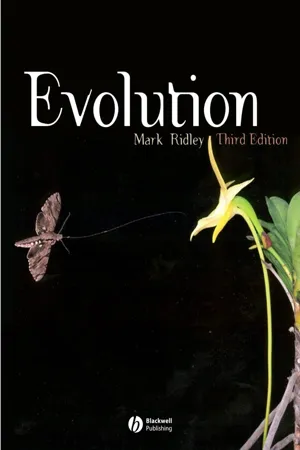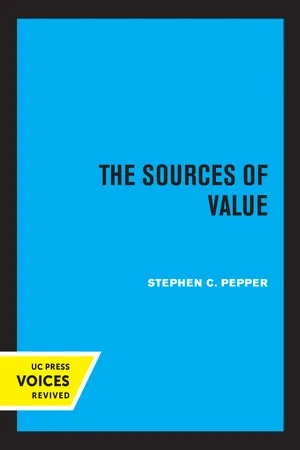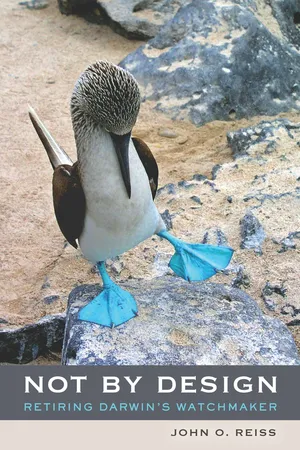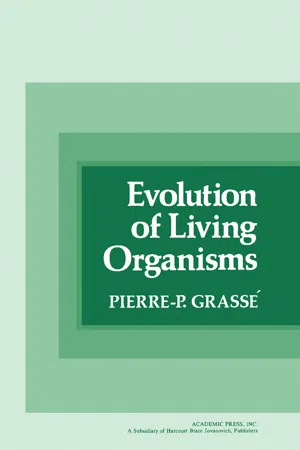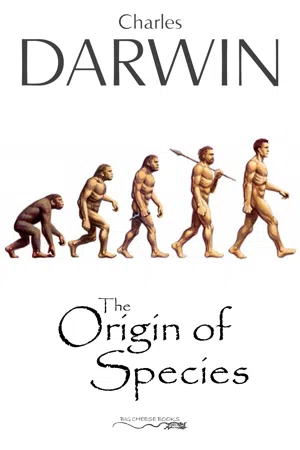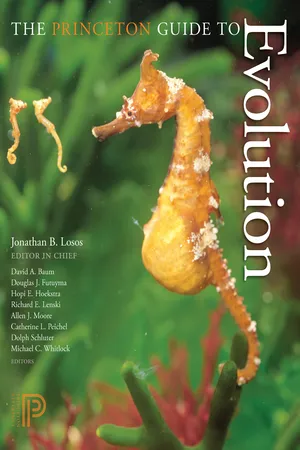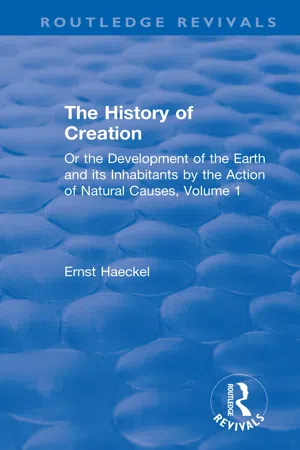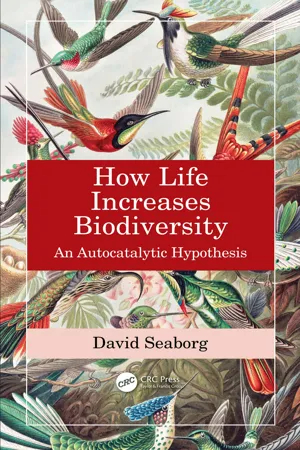Biological Sciences
Natural Selection
Natural selection is a fundamental mechanism of evolution, proposed by Charles Darwin. It describes the process by which organisms with advantageous traits are more likely to survive and reproduce, passing on those traits to their offspring. Over time, this leads to the accumulation of beneficial traits within a population, driving the adaptation of species to their environment.
Written by Perlego with AI-assistance
Related key terms
1 of 5
12 Key excerpts on "Natural Selection"
- No longer available |Learn more
- (Author)
- 2014(Publication Date)
- University Publications(Publisher)
In other words, Natural Selection is an important process (though not the only process) by which evolution takes place within a population of organisms. As opposed to artificial selection, in which humans favor specific traits, in Natural Selection the environment acts as a sieve through which only certain variations can pass. Natural Selection is one of the cornerstones of modern biology. The term was introduced by Darwin in his influential 1859 book On the Origin of Species , in which Natural Selection was described as analogous to artificial selection, a process by which animals and plants with traits considered desirable by human breeders are systematically favored for reproduction. The concept of Natural Selection was originally developed in the absence of a valid theory of heredity; at the time of Darwin's writing, nothing was known of modern genetics. The union of traditional Darwinian evolution with subsequent discoveries in classical and molecular genetics is termed the modern evolutionary synthesis . Natural Selection remains the primary explanation for adaptive evolution. ________________________ WORLD TECHNOLOGIES ________________________ General principles Darwin's illustrations of beak variation in the finches of the Galápagos Islands, which hold 13 closely related species that differ most markedly in the shape of their beaks. The beak of each species is suited to its preferred food, suggesting that beak shapes evolved by Natural Selection. Natural variation occurs among the individuals of any population of organisms. Many of these differences do not affect survival (such as differences in eye color in humans), but some differences may improve the chances of survival of a particular individual. A rabbit that runs faster than others may be more likely to escape from predators, and algae that are more efficient at extracting energy from sunlight will grow faster. - eBook - PDF
- Todd K. Shackelford(Author)
- 2022(Publication Date)
- Cambridge University Press(Publisher)
This might sound surprising to those less familiar with evolutionary theory. How can the most important idea in the history of biological thought be a tautology? The term “Natural Selection” often conjures a grand notion of some abstract, goal-directed agent – Mother Nature herself – consciously evaluating populations and selecting the organisms she deems worthy. This misleading perception is not helped by the fact that evolutionary scientists often find it expedient to use phrases like “selected for/against” to describe the process of some entities becoming or remaining more numerous than others over time. It can be difficult to accept or understand the simplicity and inevitability of a force like Natural Selection when faced with the astounding diversity and functional complexity observed in its products. The confusion often comes down to a conflation of the phenomenon of Natural Selection, on the one hand, and the theory of evolution by Natural Selection, on the other. The latter is the theory initially proposed by Charles Darwin in 1859 and expanded by many scientists in the subsequent century. It is the best accepted scientific explanation of the origin of biodiversity and biological adaptation; it is a mechanism of systematic change in populations over time. It is a complex theory that has spawned many subtheories and niche fields of investigation. Natural Selection itself was identified by Darwin as the key mechanism operating within the theory – but Natural Selection itself is not a theory. It’s a simple fact, not only of nature, but of any population of reproducing entities that satisfies three preconditions: variation, inheritance, and nonrandom differential reproduction (Godfrey-Smith, 2009; Heams, Huneman, Lecointre, & Silberstein, 2015). To begin with, 1. variation in the population’s traits is a necessary precondition for certain entities to become more numerous than others. - eBook - PDF
- Mark Ridley(Author)
- 2009(Publication Date)
- Wiley-Blackwell(Publisher)
4.2 Natural Selection operates if some conditions are met The excess fecundity, and consequent competition to survive in every species, provide the preconditions for the process Darwin called Natural Selection. Natural Selection is easiest to understand, in the abstract, as a logical argument, leading from premises to conclusion. The argument, in its most general form, requires four conditions: 1. Reproduction. Entities must reproduce to form a new generation. 2. Heredity. The offspring must tend to resemble their parents: roughly speaking, “like must produce like.” 3. Variation in individual characters among the members of the population. If we are studying Natural Selection on body size, then different individuals in the population must have different body sizes. (See Section 1.3.1, p. 7, on the way biologists use the word “character.”) 4. Variation in the fitness of organisms according to the state they have for a heritable character. In evolutionary theory, fitness is a technical term, meaning the average number of offspring left by an individual relative to the number of offspring left by an average member of the population. This condition therefore means that indi- viduals in the population with some characters must be more likely to reproduce (i.e., have higher fitness) than others. (The evolutionary meaning of the term fitness differs from its athletic meaning.) If these conditions are met for any property of a species, Natural Selection automatic- ally results. And if any are not, it does not. Thus entities, like planets, that do not reproduce, cannot evolve by Natural Selection. Entities that reproduce but in which parental characters are not inherited by their offspring also cannot evolve by Natural Selection. But when the four conditions apply, the entities with the property conferring 74 PART 1 / Introduction .. The struggle for existence refers to ecological competition The theory of Natural Selection can be understood as a logical argument - eBook - PDF
- Stephen C. Pepper(Author)
- 2023(Publication Date)
- University of California Press(Publisher)
There is no evidence that the highly specialized adaptations characteristic of insects are ceasing to be biologically advantageous to them in spite of the advent of man. Evolution and Survival Value 627 It is only in man's life zone that Julian Huxley's criteria of progress can have an application, and this would be sufficient unto man. But there is no adequate evidence for the continuous progress concept of evolution. Not through this concept shall we look for a natural norm of survival value. We shall find it operating in a much less grandiose manner, as the process of Natural Selection itself, operating wherever life is, in a multitude of rather separate zones of life, each zone instituting its own natural norm of adaptation or adaptability. 4. THE PROCESS OF Natural Selection We are now prepared to consider the process of Natural Selection as a selective system instituting survival value. Because it is a selective system, we shall expect to find (1) a dynamic element comparable to the drive in a purposive structure, (2) a selective element comparable to the superordinate-subordinate act struc- ture of a purpose, and (3) that peculiarity of a split dynamics which assures that the same dynamic element which puts in ac- tion the normatively correct result likewise charges the nor- matively corrected erroneous result. The dynamic element for Natural Selection in organic evolution is the vital energy of an interbreeding population of individual organisms. The population constitutes a distinctive group by virtue of their reproductive association. Such a group is roughly what is known as a species. When two groups cannot reproduce by crossbreeding, they are generally referred to as different spe- cies. The converse, however, does not hold. Different species can sometimes crossbreed and produce hybrids. The determina- tion of distinct species is consequently a difficult and contro- versial matter for technical biology. - eBook - PDF
Evolutionary Ecology of Plant-Plant Interactions
An Empirical Modelling Approach
- Christian Damgaard(Author)
- 2005(Publication Date)
- Aarhus University Press(Publisher)
6. Natural Selection Mode of selection While most of the genetic variation found in plant populations probably is selectively neutral (Kimura 1983), some genetic variation makes a dif- ference. Some genotypes will code for a phenotype that in a given envi- ronment on average, due to e.g. faster growth or a better defence against parasites, will leave more offspring in the next generation. Natural Selection is composed of three principles (Lewontin 1970): 1) Different individuals in a population have different morphologies and physiologies (phenotypic variation). 2) Different phenotypes have different rates of survival and reproduc- tion in different environments (differential fitness). 3) There is a correlation between parents and offspring in the contribu- tion of each to future generations (fitness is heritable). The fitness of a phenotype depends on many different characters that typically are correlated and determined by a combination of geno- typic and environmental factors. The genotypic difference that causes the average increase in the number of descendants may be a single allele (a Mendelian character) or a number of alleles in a favourable combina- tion (a quantitative character), and such alleles will on average increase in frequency due to Natural Selection (Wright 1969). The consequent in- crease in mean fitness caused by Natural Selection is equal to the genetic variance in fitness (Fisher 1958, Frank 1997). Since the biological world has so many different life forms and re- productive strategies it is not operational to give a precise and complete definition of fitness (Lewontin 1970). Instead, it is convenient to define fitness relative to the studied organism. Where the ecological success of a plant species at a specific place only depended on fecundity and vi- ability (chapters 2-4), the fitness of an individual sexual plant depends on the number of gametes transmitted to the next generation by both the maternal and the paternal line. - eBook - PDF
Not by Design
Retiring Darwin’s Watchmaker
- John Reiss(Author)
- 2009(Publication Date)
- University of California Press(Publisher)
225 9 Natural Selection and Genetic Drift Their Role in Evolutionary Change The customary uses of the term Natural Selection are not only vague, but discrepant, and please imagine what theoretical physics would be like if we not only all talked about the second law of thermodynamics but meant materially different things by the phrase. — R . A . FISHER , 1930 , LETTER TO E . B . WILSON If we turn to any modern textbook of evolutionary biology (e.g., Ridley 2004 ; Futuyma 2005 ; Freeman and Herron 2007 ), we find agreement on some of the ba-sics of evolutionary theory. In particular, the general view of evolution is that it is a process that involves three main “forces” or processes: mutation, natural selec-tion, and genetic drift. Unlike mutation, both Natural Selection and genetic drift in-volve differential survival and reproduction among classes of lineages. Neverthe-less, “adaptive evolution” and “adaptations” are ascribed exclusively (or almost so) to Natural Selection, not to genetic drift (or mutation), much as Fisher, Wright, and Haldane did in the beginning years of the synthesis. To know what this means, how-ever, depends critically on how Natural Selection and genetic drift are defined—if we don’t know what they are, we certainly can’t decide which evolutionary change to ascribe to each of them. Unfortunately, a critical examination of such introduc-tory textbooks immediately makes it clear that no agreed-on definition of Natural Selection or drift exists, but rather several competing definitions, each used depend-ing on the circumstance. For example, two key questions in the definition of Natural Selection have to be ( 1 ) does it include inheritance or merely work with inheritance?, and ( 2 ) does it involves differential survival and reproduction of classes of entities, due to the features by which we define them (narrow sense selection), or merely differential survival and reproduction of classes of entities (medium sense selection)? In other - eBook - PDF
Evolution of Living Organisms
Evidence for a New Theory of Transformation
- Pierre-P. Grassé(Author)
- 2013(Publication Date)
- Academic Press(Publisher)
V Evolution and Natural Selection Evolution as imagined by the Darwinian school, using mutants as its building blocks, cannot do without chance, which provides it with its material, but the selection to which evolution resorts in order to adjust mutations to necessity or simply utility becomes antichance. The keeper of order. Thus, in its most elaborate form the doctrine endeavors to reconcile opposing elements, chaos and order. It consequently links adaptation and selection tightly together, the former depending upon the latter. This conception affects both the way in which the usefulness of the characteristics of living things is to be judged and the genesis of the adaptation is interpreted. Therefore, any critique of the doctrine should relate to both of these notions; we shall now devote one chapter to each in turn. THE NOTION OF SELECTION The image of selection sifting through the variants in a given popula-tion, sorting out the fit from the unfit, was expressed long before the nineteenth century by a great many naturalists or philosophers. Aristo-tle, that universal precursor, even enunciated the principle of the strug-gle for life: 'The animals are at war with one another whenever they live in the same places and take the same food. If food is scarce they fight, even when they belong to the same species. He even asks, in the Physics (Book II, Chapter 8), whether such fighting may not have caused the extinction of forms insufficiently adapted to living condi-tions, and the conservation of those which are so adapted, whence the apparent finality we observe. But he at once rejects the idea, seeing that finality is in nature as the exception and not the rule; moreover, he believes the resources of nature are great enough to make it impossible 108 Chance and Organic Complexity 109 for any one of its works to be destroyed. What is more, not all animals fight one another, some are friends (Perrier, 1896, p. 16). - eBook - ePub
- Charles Darwin(Author)
- 2019(Publication Date)
- Big Cheese Books(Publisher)
How will the struggle for existence, briefly discussed in the last chapter, act in regard to variation? Can the principle of selection, which we have seen is so potent in the hands of man, apply under nature? I think we shall see that it can act most efficiently. Let the endless number of slight variations and individual differences occurring in our domestic productions, and, in a lesser degree, in those under nature, be borne in mind; as well as the strength of the hereditary tendency. Under domestication, it may be truly said that the whole organisation becomes in some degree plastic. But the variability, which we almost universally meet with in our domestic productions, is not directly produced, as Hooker and Asa Gray have well remarked, by man; he can neither originate varieties, nor prevent their occurrence; he can preserve and accumulate such as do occur. Unintentionally he exposes organic beings to new and changing conditions of life, and variability ensues; but similar changes of conditions might and do occur under nature. Let it also be borne in mind how infinitely complex and close-fitting are the mutual relations of all organic beings to each other and to their physical conditions of life; and consequently what infinitely varied diversities of structure might be of use to each being under changing conditions of life. Can it, then, be thought improbable, seeing that variations useful to man have undoubtedly occurred, that other variations useful in some way to each being in the great and complex battle of life, should occur in the course of many successive generations? If such do occur, can we doubt (remembering that many more individuals are born than can possibly survive) that individuals having any advantage, however slight, over others, would have the best chance of surviving and of procreating their kind? On the other hand, we may feel sure that any variation in the least degree injurious would be rigidly destroyed. This preservation of favourable individual differences and variations, and the destruction of those which are injurious, I have called Natural Selection, or the Survival of the Fittest. Variations neither useful nor injurious would not be affected by Natural Selection, and would be left either a fluctuating element, as perhaps we see in certain polymorphic species, or would ultimately become fixed, owing to the nature of the organism and the nature of the conditions.Several writers have misapprehended or objected to the term Natural Selection. Some have even imagined that Natural Selection induces variability, whereas it implies only the preservation of such variations as arise and are beneficial to the being under its conditions of life. No one objects to agriculturists speaking of the potent effects of man’s selection; and in this case the individual differences given by nature, which man for some object selects, must of necessity first occur. Others have objected that the term selection implies conscious choice in the animals which become modified; and it has even been urged that, as plants have no volition, Natural Selection is not applicable to them! In the literal sense of the word, no doubt, Natural Selection is a false term; but who ever objected to chemists speaking of the elective affinities of the various elements? — and yet an acid cannot strictly be said to elect the base with which it in preference combines. It has been said that I speak of Natural Selection as an active power or Deity; but who objects to an author speaking of the attraction of gravity as ruling the movements of the planets? Every one knows what is meant and is implied by such metaphorical expressions; and they are almost necessary for brevity. So again it is difficult to avoid personifying the word Nature; but I mean by Nature, only the aggregate action and product of many natural laws, and by laws the sequence of events as ascertained by us. With a little familiarity such superficial objections will be forgotten. - eBook - ePub
- David A. Baum, Douglas J. Futuyma, Hopi E. Hoekstra, Richard E. Lenski, Allen J. Moore, Catherine L. Peichel, Dolph Schluter, Michael C. Whitlock, David A. Baum, Douglas J. Futuyma, Hopi E. Hoekstra, Richard E. Lenski, Allen J. Moore, Catherine L. Peichel, Dolph Schluter, Michael C. Whitlock(Authors)
- 2013(Publication Date)
- Princeton University Press(Publisher)
VII.9 ) illustrate that Natural Selection can even operate at the level of groups of kin and maybe even at the level of groups of unrelated individuals that share certain traits.In short, the theory of evolution by Natural Selection provides a richly textured framework by which to understand an enormous diversity of evolutionary phenomena. Yet underneath all of this diversity lies Darwin’s fundamental insight: Heritable characteristics that enhance the probability of survival and reproduction will tend to become more common, and those that reduce fitness will tend to be eliminated.FURTHER READINGClark, A. G., and M. W. Feldman. 1981. Density-dependent fertility selection in experimental populations of Drosophila melanogaster. Genetics 98: 849–869.Endler, J.A. 1986. Natural Selection in the Wild. Princeton, NJ: Princeton University Press. Frank, S. A. 2012. Natural Selection. V. How to read the fundamental equations of evolutionary change in terms of information theory. Journal of Evolutionary Biology 25: 2377–2396. Hurst, L. D. 2009. Genetics and the understanding of selection. Nature Reviews Genetics 10: 83–93. Travis, J. 1989. The role of optimizing selection in natural populations. Annual Review of Ecology and Systematics 20: 279–296.Passage contains an image III.4 Kin Selection and Inclusive Fitness David C. Queller and Joan E. Strassmann
OUTLINE1. The problem of altruism 2. Inclusive fitness and Hamilton’s rule 3. Kinds of social selection 4. Comparative evidence in social insects 5. Experimental evidence in microbes 6. Kin recognition 7. Challenges to kin selectionKin selection is selection that operates via effects on relatives. It is the explanation for altruistic behavior, where an actor gives up fitness in order to help other individuals, because the trait can spread only through possession of the altruism gene by beneficiaries. It also applies to other forms of behavior toward relatives, including selfish behavior. Kin selection, and the associated but broader concept of inclusive fitness, is supported by many theoretical models and empirical studies. - eBook - ePub
The History of Creation
Or the Development of the Earth and its Inhabitants by the Action of Natural Causes, Volume 1
- Ernst Haeckel(Author)
- 2019(Publication Date)
- Taylor & Francis(Publisher)
Chapter XI. Natural Selection by the Struggle for Existence. Cellular Selection and Personal Selection. Interaction of the Two Organic Formative Causes, Inheritance and Adaptation.—Natnral and Artificial Selection.—Struggle for Existence, or Competition for the Necessaries of Life.—Disproportion between the Number of Possible or Potential, and the Number of Eeal or Actual Individuals.—Complicated Correlations of all Neighbouring Organisms. —Mode of Action in Natural Selection.—Homochromic Selection as the Cause of Sympathetic Colourings.—Sexual Selection as the Cause of the Secondary Sexual Characters.—The Struggle of Parts in the Organism (Uoux).—Functional Self-Formation of Suitable Structures. —Teleological Mechanism.—Cellular Selection (Protista) and Personal Selection (Histonse).—Selection of the Cells and of the Tissues.— The Principle of Selection in Empedocles.—Mechanical Origin of what is Suitable for a Purpose from what is Unsuitable.—Philosophical Bange of Darwinism. I N order to arrive at a right understanding of Darwinism, it is, above all, necessary that the two organic functions of Inheritance and Adaptation, which we examined in our last chapters, should be more closely examined. If we do not, on the one hand, examine the purely mechanical nature of these two physiological activities, and the various action of their different laws, and if, on the other hand, we do not consider how complicated the interaction of these different laws of Inheritance and Adaptation must be, we shall not be able to understand how these two functions, by themselves, have been able to produce all the variety of animal and vegetable forms, which, in fact, they have. We have, at least, hitherto been unable to discover any other formative causes besides these two, and if we rightly understand the necessary and infinitely complicated interaction of Inheritance and Adaptation, we do not require to look for other unknown causes for the change of organic forms - Paul H Barrett(Author)
- 2016(Publication Date)
- Taylor & Francis(Publisher)
This is an extremely intricate subject. A great amount of variability, under which term individual differences are always included, will evidently be favourable. A large number of individuals, by giving a better chance within any given period for the appearance of profitable variations, will compensate for a lesser amount of variability in each individual, and is, I believe, a highly important element of success. Though nature grants long periods of time for the work of Natural Selection, she does not grant an indefinite period; for as all organic beings are striving to seize on each place in the economy of nature, if any one species does not become modified and improved in a corresponding degree with its competitors, it will be exterminated. Unless favourable variations be inherited by some at least of the offspring, nothing can be effected by Natural Selection. The tendency to reversion may often check or prevent the work; but as this tendency has not prevented man from forming by selection numerous domestic races, why should it prevail against Natural Selection?In the case of methodical selection, a breeder selects for some definite object, and if the individuals be allowed freely to intercross, his work will completely fail. But when many men, without intending to alter the breed, have a nearly common standard of perfection, and all try to procure and breed from the best animals, improvement surely but slowly follows from this unconscious process of selection, notwithstanding that there is no separation of selected individuals. Thus it will be under nature; for within a confined area, with some place in the natural polity not perfectly occupied, all the individuals varying in the right direction, though in different degrees, will tend to be preserved. But if the area be large, its several districts will almost certainly present different conditions of life; and then, if the same species undergoes modification in different districts, the newly-formed varieties will intercross on the confines of each. But we shall see in the sixth chapter that intermediate varieties, inhabiting intermediate districts, will in the long run generally be supplanted by one of the adjoining varieties. Intercrossing will chiefly affect those animals which unite for each birth and wander much, and which do not breed at a very quick rate. Hence with animals of this nature, for instance, birds, varieties will generally be confined to separated countries; and this I find to be the case. With hermaphrodite organisms which cross only occasionally, and likewise with animals which unite for each / birth, but which wander little and can increase at a rapid rate, a new and improved variety might be quickly formed on any one spot, and might there maintain itself in a body and afterwards spread, so that the individuals of the new variety would chiefly cross together. On this principle, nurserymen always prefer saving seed from a large body of plants, as the chance of intercrossing is thus lessened.- eBook - ePub
How Life Increases Biodiversity
An Autocatalytic Hypothesis
- David Seaborg(Author)
- 2021(Publication Date)
- CRC Press(Publisher)
3 Natural Selection Is One Mechanism by Which the Autocatalytic Biodiversity Hypothesis OperatesThe theory of evolution by Natural Selection of Darwin and Wallace is one of the mechanisms by which the ABH works. The ability of organisms to adapt to environmental challenges allows them to persist and thus maintains diversity. It also allows species to have macroevolutionary breakthroughs to new adaptive zones, such as the colonization of land by marine vertebrates. This gives access to many new niches and so is followed by adaptive radiation to many new species and forms. Natural Selection is also involved in speciation, increasing species number. Adaptation by organisms is a mechanism by which life maintains and increases diversity. The ABH is supported by the fact that speciation is mostly actively driven by organisms, which do not speciate as entirely passive agents of selection.EXTRAORDINARY ABILITY OF ORGANISMS TO ADAPT BY Natural Selection
The power of Natural Selection and life’s incredible capacity to respond to selective forces, adapt to extreme environments, and evolve innovative, unusual, and amazing adaptations are phenomenal. This maintains diversity, and increases it when it leads to speciation, and when it leads to macroevolutionary breakthroughs followed by adaptive radiation. Some examples of life’s extraordinary ability to adapt, as well as spectacular adaptations, follow.The archaea Pyrolobus fumarii and Pyrococcus furiosus live in submarine hydrothermal vents at temperatures higher than boiling water, at 110°C–121°C. Archaea in genus Pyrococcus in the Mariana Trench survive in extraordinarily high pressures that would kill people, at 1,100 bars. The cyanobacterium Synechococcus lividus lives in freezing ice habitats at −17°C to −20°C. Some bacteria in the genera Psychrobacter , Vibrio , and Arthrobacter , and some archaea in genus Natronobacterium live in extremely basic soda lakes with a pH over 11, which would easily damage human skin. Bacterium Clostridium paradoxum and some bacteria in genus Bacillus thrive in volcanic springs and acid mine drainages with acid strong enough to eat away human flesh, at a pH below 0.1. The Green microalga Dunaliella salina grows in highly saline conditions, such as salt evaporation ponds. Bacterium Deinococcus radiodurans , some bacteria in genus Rubrobacter , and archaeon Thermococcus gammatolerans can survive extreme ionizing radiation up to 1,500–6,000 Gy, in the form of cosmic rays, X-rays, or radioactive decay, and UV radiation up to 5,000 J/m2 . Cyanobacterium Chroococcidiopsis thrives in extreme conditions of high and low temperatures, ionizing radiation, and high salinity. Other microbes can withstand very high salt concentrations of 0.2 M NaCl, and others can tolerate dissolved heavy metals, including copper, cadmium, arsenic, and zinc, in such high levels that they are toxic to most organisms. The bacterium Halomonas titanicae lives at the sea bottom, and sticks to steel surfaces such as ships, and eats them, obtaining iron. Microbial populations that survived in ice for 750,000 years in the Qinghan-Tibetan plateau were subjected to ionizing radiation and kept at 5°F in a laboratory for 2 years, and shown to have fully functional DNA repair mechanisms in freezing conditions. A mix of archaea, bacteria, and fungi in Chile’s Atacama Desert survived in several places by going dormant, surviving dessication, and high salinity and UV light. Species of these at various sampling sites grew and thrived when rain came in March 2005 [1 ]. Ideonella sakaiensis is a bacterium that dwells in soil and wastewater, and has evolved the ability to eat a strong, human-made plastic fiber as its main food source [2
Index pages curate the most relevant extracts from our library of academic textbooks. They’ve been created using an in-house natural language model (NLM), each adding context and meaning to key research topics.
